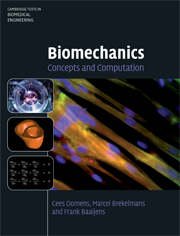Book contents
- Frontmatter
- Contents
- About the cover
- Preface
- 1 Vector calculus
- 2 The concepts of force and moment
- 3 Static equilibrium
- 4 The mechanical behaviour of fibres
- 5 Fibres: time-dependent behaviour
- 6 Analysis of a one-dimensional continuous elastic medium
- 7 Biological materials and continuum mechanics
- 8 Stress in three-dimensional continuous media
- 9 Motion: the time as an extra dimension
- 10 Deformation and rotation, deformation rate and spin
- 11 Local balance of mass, momentum and energy
- 12 Constitutive modelling of solids and fluids
- 13 Solution strategies for solid and fluid mechanics problems
- 14 Solution of the one-dimensional diffusion equation by means of the Finite Element Method
- 15 Solution of the one-dimensional convection-diffusion equation by means of the Finite Element Method
- 16 Solution of the three-dimensional convection-diffusion equation by means of the Finite Element Method
- 17 Shape functions and numerical integration
- 18 Infinitesimal strain elasticity problems
- References
- Index
4 - The mechanical behaviour of fibres
Published online by Cambridge University Press: 05 June 2012
- Frontmatter
- Contents
- About the cover
- Preface
- 1 Vector calculus
- 2 The concepts of force and moment
- 3 Static equilibrium
- 4 The mechanical behaviour of fibres
- 5 Fibres: time-dependent behaviour
- 6 Analysis of a one-dimensional continuous elastic medium
- 7 Biological materials and continuum mechanics
- 8 Stress in three-dimensional continuous media
- 9 Motion: the time as an extra dimension
- 10 Deformation and rotation, deformation rate and spin
- 11 Local balance of mass, momentum and energy
- 12 Constitutive modelling of solids and fluids
- 13 Solution strategies for solid and fluid mechanics problems
- 14 Solution of the one-dimensional diffusion equation by means of the Finite Element Method
- 15 Solution of the one-dimensional convection-diffusion equation by means of the Finite Element Method
- 16 Solution of the three-dimensional convection-diffusion equation by means of the Finite Element Method
- 17 Shape functions and numerical integration
- 18 Infinitesimal strain elasticity problems
- References
- Index
Summary
Introduction
Fibres and fibre-like structures play an important role in the mechanical properties of biological tissues. Fibre-like structures may be found in almost all human tissues. A typical example is the fibre reinforcement in a heart valve, Fig. 4.1(a). Another illustration is found in the intervertebral disc as shown in Fig. 4.1(b).
Fibre reinforcement, largely inspired by nature, is frequently used in prosthesis design to optimize mechanical performance. An example is found in the aortic valve prosthesis, see Fig. 4.2.
Fibres are long slender bodies and, essentially, have a tensile load bearing capacity along the fibre direction only. The most simple approximation of the, often complicated, mechanical behaviour of fibres is to assume that they behave elastically. In that case fibres have much in common with springs. The objective of this chapter is to formulate a relation between the force in the fibre and the change in length of a fibre. Such a relation is called a constitutive model.
Elastic fibres in one dimension
Assume, for the time being, that the fibre is represented by a simple spring as sketched in Fig. 4.3. At the left end the spring is attached to the wall while the right end is loaded with a certain force F. If no load is applied to the spring (fibre) the length of the spring equals l0, called the reference or initial length.
- Type
- Chapter
- Information
- BiomechanicsConcepts and Computation, pp. 50 - 68Publisher: Cambridge University PressPrint publication year: 2009



